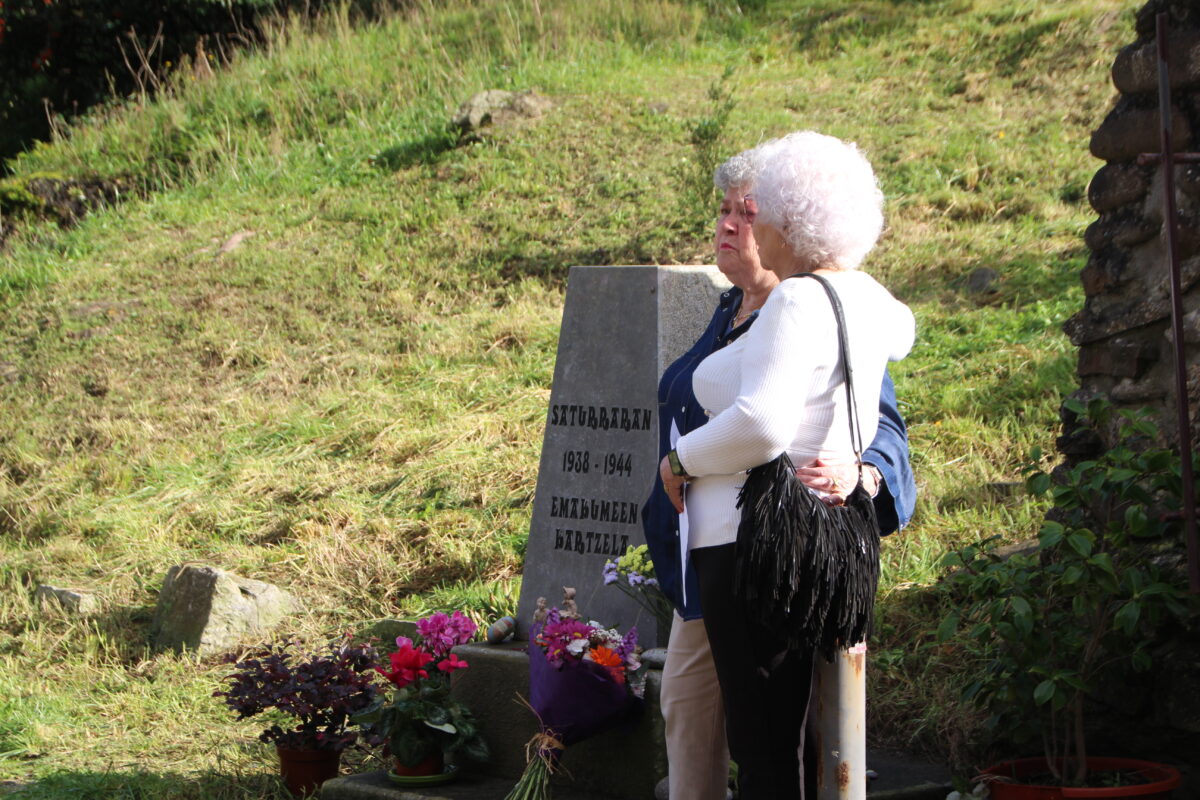
Memory and recognition. These are two elements necessary for the official stories to highlight the hidden, in short, to tell the experiences and the demands of those who have not had words throughout history, kept in memory and in the heart, to continue disseminating what happened. On Saturday, Memory Day, they met to pay tribute to the women and children who were imprisoned in Saturraran prison, “to keep shaking the memory.”
The event started at 12:00 hours, coinciding with the sound of the txalaparta at the Arriaga Theatre. Then there was a floral offering and a souvenir greeting to the women and children who were imprisoned in Saturraran prison. They have also received tribute to Nikolasa Agirrezabalaga Amutxastegi, from Mutriku, shot on 13 December in Zaragoza, at the age of 22, as a result of a false denunciation: “He was tried without a defence, and until the morning they were going to kill him, he didn’t know he was sentenced to death.”
A tribute has also been paid to Asturian Angels Florez Peón, ‘Maricuela’, who was imprisoned in 1938 in Saturraran prison: “He died on May 23 in Gijón, at the age of 105. At the age of 16, they fusified their brother on a mine strike, and that's when the socialist, in the war, was also a militia. When Iparralde’s front fell, he was arrested and sentenced to 15 years in prison.” When she was taken to Saturraran prison, Angels Flores was only twenty years old and kept in the building across the bridge, “I had never seen a child in Saturraran. How many meters are there from building to building? So close and so far. The incommunication between the prisoners was great.” Florez had the opportunity to meet Raúl Blanco, a boy who had spent in Saturraran, but he insisted that he had not seen children in the three years he was in jail. “For you have taught us what you have suffered because of war and war, and we want to thank you for all the work done for democracy; for you, our reputation and applause ‘Maricuela’.”
And of course, they have paid homage to all the children who have been in Saturraran: “Mertxe Gallardo Carrilo. Child born in Saturraran on 3 March 1940. Andalusian mother, Eusebia Carrilo Marín. Here we have Mertxe Gallardo Carrilo, our reputation and applause, him and all those who, like her and her mother, were imprisoned in Saturraran.” Also present were the descendants of the prisoners of the mother, grandmother or relative of Saturraran, as well as the families welcomed a child, “if we have direct witnesses, it is up to us to remember what has happened here and not to forget the harsh moments that the prisoners have gone through”.
In addition to the suffering, the organizers wanted to underline the solidarity that has been shown around this story: “Each diner ate two tablespoons less and brought the food in a saucepan to the prisoner of Saturraran. The neighbours of Mutriku and Ondarroa were responsible for taking the children in their arms and protecting them. Karmina, Asun, Anita… always had words of thanks to the neighbours of Ondarroa and Mutriku, who supported them.”
The Saturraran Association has continued the act with words of thanks: “We wish to express our thanks to all the people who have approached Saturraran again today, for the effort you have made to integrate into the memory what has happened and because as we count the following people, the 116 women and the 61 children who died in the Saturraran building will not be forgotten. We have to keep it in our memory and in our hearts and continue to spread the story around us so that we don’t forget.”
With the song dedicated to the women of Saturraran prison and the song Txoriak Txori by Mikel Laboa, all the attendees have closed the act turning the act into an “exciting” moment: “Where are they? Which hole? One hundred and eighty deaths. Emelina, Agapita, Aurora and Welcome, who went forever.”
Kirola eta oroimena uztartuko dituzte, bigarrenez, mendi-martxa baten bitartez. Ez da lehiakorra izanen, helburua beste bat delako. La Fuga izeneko mendi martxak 1938ko sarraskia gogorarazi nahi du. Ezkabako gotorlekuan hasi eta Urepelen amaituko da. Maiatzaren 17an eginen dute.
Fusilamenduak, elektrodoak eta poltsa, hobi komunak, kolpismoa, jazarpena, drogak, Galindo, umiliazioak, gerra zikina, Intxaurrondo, narkotrafikoa, estoldak, hizkuntza inposaketa, Altsasu, inpunitatea… Guardia Zibilaren lorratza iluna da Euskal Herrian, baita Espainiako... [+]
Gogora Institutuak 1936ko Gerrako biktimen inguruan egindako txostenean "erreketeak, falangistak, Kondor Legioko hegazkinlari alemaniar naziak eta faxista italiarrak" ageri direla salatu du Intxorta 1937 elkarteak, eta izen horiek kentzeko eskatu du. Maria Jesus San Jose... [+]
Familiak eskatu bezala, aurten Angel oroitzeko ekitaldia lore-eskaintza txiki bat izan da, Martin Azpilikueta kalean oroitarazten duen plakaren ondoan. 21 urte geroago, Angel jada biktima-estatus ofizialarekin gogoratzen dute.
Bilbo Hari Gorria dinamikarekin ekarriko ditu gurera azken 150 urteetako Bilboko efemerideak Etxebarrieta Memoria Elkarteak. Iker Egiraun kideak xehetasunak eskaini dizkigu.
33/2013 Foru Legeari Xedapen gehigarri bat gehitu zaio datozen aldaketak gauzatu ahal izateko, eta horren bidez ahalbidetzen da “erregimen frankistaren garaipenaren gorespenezkoak gertatzen diren zati sinbolikoak erretiratzea eta kupularen barnealdeko margolanak... [+]
1976ko martxoaren 3an, Gasteizen, Poliziak ehunka tiro egin zituen asanbladan bildutako jendetzaren aurka, zabalduz eta erradikalizatuz zihoan greba mugimendua odoletan ito nahian. Bost langile hil zituzten, baina “egun hartan hildakoak gehiago ez izatea ia miraria... [+]
Memoria eta Bizikidetzako, Kanpo Ekintzako eta Euskarako Departamentuko Memoriaren Nafarroako Institutuak "Maistrak eta maisu errepresaliatuak Nafarroan (1936-1976)" hezkuntza-webgunea aurkeztu du.